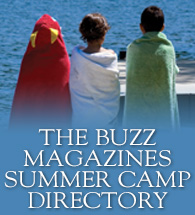Sunday Mornings with Rania: The Momo Challenge

 By now, you’ve definitely heard about it. You’ve seen the disturbing photo, you’ve read the rumors of children hurting themselves in response, you’ve seen the images, heard it was a hoax - all while shaking your head in disbelief. Like me, you’re concerned because whether the “Momo Challenge” is true or not, truth is, your kids have seen the frightening photo and heard about the stories. So, what is the origin of all of this, should we be concerned and what do we do now?
By now, you’ve definitely heard about it. You’ve seen the disturbing photo, you’ve read the rumors of children hurting themselves in response, you’ve seen the images, heard it was a hoax - all while shaking your head in disbelief. Like me, you’re concerned because whether the “Momo Challenge” is true or not, truth is, your kids have seen the frightening photo and heard about the stories. So, what is the origin of all of this, should we be concerned and what do we do now?
In the beginning
I guess it’s safe to say it started in Japan. The “momo” is a nickname given to a cropped photo of a sculpture created by the artist Keisuke Aisawa for a Japanese special-effects company Link Factory. Called the “Mother Bird,” the statue was displayed at a Tokyo gallery that specialized in “horror art” in 2016. The sculpture features a young woman with long black hair, large bulging eyes, a wide smile and bird legs.
Soon enough, the photo began circulating online with an urban legend attached involving a WhatsApp phone number that messaged disturbing photos to those that attempted to contact it. A game developed called the “Momo Challenge” whereby the challenges allegedly sent back to those brave enough to WhatsApp Momo were harmful and frightening.
Like all things online, the challenge surfaced again last week with rumors that Momo was popping up on YouTube kids shows (particularly in Peppa Pig shows) and other platforms with messages specifically targeting youngsters to harm themselves. Rumors fueled “reports” but no such incidents have been found.
So now what?
Real or not, by now, we have all seen Momo’s disturbing photo and read headlines that indicate Momo is about self-harm. Guess who else has seen those images and the headlines? Our children. Real or fake, a disturbing seed has been planted, so we need a gameplan. Here are recommendations for navigating the world of memes, challenges, hoaxes and other disturbing data the online world throws at us:
- Stay ahead of the curve. This is difficult but parents, if your children are online, we have a responsibility to stay ahead of these things and to proactively talk to your kids about it. The conversation could look like this - guys, there’s a disturbing image that circulating right now. I wish I could keep you from seeing it, but you’ll most likely see it somewhere. It’s a picture of [insert description in an age-appropriate manner]. It’s just a photo and there’s no one with ill will behind it. If you see it, don’t be afraid, just move on. Let us know so we can discuss it with you as well.
- Share the rumors with your children, only. Instead of sharing the rumors online (especially on social media), make your children aware of what’s being said. Why? Because they are going to be exposed either way and we should give them the tools - preemptively - to combat what they hear. The conversation could look like this - guys, there’s a horrible image being shared on social media and some people are saying that with this photo is a push for kids to hurt themselves. It’s not true and here’s why. Also, let’s talk about things you see online and “calls to action” you may get from images, email messages, text messages, challenges and other platforms. How are you going to handle those things? What’s our family plan? The most important thing we need you to know is never, ever feel pressure from an online threat. Always tell us, always share with us. No one has to know what you saw or what was said to you, you can always tell us in confidence and we’ll figure out next steps together.
- Remember scary stories and “legends” travel like wildfire. In Momo’s case, the original tale was that Momo was an evil spirit on the internet and that if you are brave enough to message her, she will give you instructions but that if you don’t follow her instructions, she will come to your house and kill your family. Her instructions are always centered around self-harm or negative actions. It’s important to debunk the myth as quickly as you can with kids and remind them of the facts - people (unfortunately) like to share scary things but it doesn’t make the stories true.
- No blanket statements. As a parent, it’s tempting to say - no cell phones, no social media, no online gaming, no YouTube, no internet - but those are just not realistic comments in a world that is nearly 100 percent driven by online engagement. Let’s be realistic and targeted in our messaging. There are dangerous people lurking online, we must tell our children about them and teach them how to navigate those scenarios without making the claim that absolutely every person online is a predator. There are dangerous challenges and gaming devices online and we must train our children to recognize the signs without saying that all gaming devices and online platforms are bad. We must be honest, aware and realistic.
- Study, investigate and fact-check, together. There’s an old saying that says a scammer cannot hurt you if you know you’re being scammed. There’s a lot of truth to that. Similarity, kids can’t be spooked if you’ve preemptively debunked the myth. This puts the onus on us to study, investigate and continually fact-check the warnings and to share those warnings and data with our children. So in this case, a conversation can simply go this way: Momo is not a demon, a monster or a ghost. Momo is someone’s artwork. Period. Momo has no power, no voice, it doesn’t move and it has no idea the world is even talking about it. It has no power over your thoughts or actions.
- You have the power. As your children venture out in the online world, education is power and offers protection. With education they can differentiate a scary encounter from a meaningless hoax or fend off a predator’s outreach with a “block and report” or see when a friend is in need of counseling or when to say something after seeing something. Education is power. Let’s not withhold it from our kids because we are too afraid to introduce concepts in their life. As I always say, if they are not old or mature enough to handle the conversations then they are not old enough to be online, ever, period. That’s a rule of thumb we can all follow.
Remember, when it comes to protecting your children online:
- Set up all accounts, including games, to the highest privacy settings. Remember that settings reset when updates are done so be sure to check privacy settings often.
- Turn off location access to all social media accounts, games and camera.
- Utilize phone restrictions to set age limitations on your child’s mobile device.
- Let your child know that the internet is a shared space and that sometimes they may see something that is only for adults that could make them feel weird, confused or scared. Remind them that it is not their fault and show them how to report inappropriate content. If you are unsure how to report, search online (i.e., How do I report inappropriate content on YouTube?)
- Explain that no one should tell them to hurt themselves or others and they should report anyone that is trying to scare them.
- List the trusted adults in your child’s life that they can reach out to if they need help.
- Contact law enforcement if your child is threatened, sees weapons online, is assaulted, you suspect stalking, harassment or extortion.
Let’s work together to keep our kids safe by doing whatever we can to stay ahead of the trends and by sharing important information with our children and our networks. While the Momo Challenge may be a hoax, it’s gotten all of us talking about important concepts necessary to keep all kids safe. While I can’t praise this artist for his creation, I can thank him for lighting the spark on conversations that benefit us all.
Want more buzz like this? Sign up for our Morning Buzz emails.
To leave a comment, please log in or create an account with The Buzz Magazines, Disqus, Facebook, or Twitter. Or you may post as a guest.


